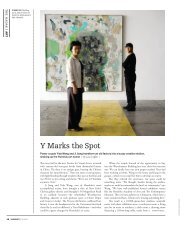PLAN 751: (6CR) Sample Planning Practicum Syllabus Course ...
PLAN 751: (6CR) Sample Planning Practicum Syllabus Course ...
PLAN 751: (6CR) Sample Planning Practicum Syllabus Course ...
You also want an ePaper? Increase the reach of your titles
YUMPU automatically turns print PDFs into web optimized ePapers that Google loves.
<strong>PLAN</strong> <strong>751</strong>: (<strong>6CR</strong>) <strong>Sample</strong> <strong>Planning</strong> <strong>Practicum</strong> <strong>Syllabus</strong><br />
<strong>Course</strong> Description:<br />
The <strong>Planning</strong> <strong>Practicum</strong> involves six to ten students and a faculty member engaging in a<br />
planning process. The emphasis is on dealing with an immediate set of planning issues.<br />
Topic varies. Pre 600, 601 and consent.<br />
General <strong>Practicum</strong> Description<br />
Each <strong>Practicum</strong> produces a final report and/or provides specific clients with<br />
planning assistance such as analyses, surveys, design and /or evaluation. Each practicum<br />
team is involved in bounding a selected problem, setting its objectives, assessing its own<br />
resources, determining the work to be performed, allocating its resources, delivering a<br />
product and /or service, and evaluating its effectiveness. The practicum provides a student<br />
with an opportunity to bring together multiple planning elements within the context of a<br />
real world-problem.<br />
Some practicum produces widely disseminated, published reports, often for specific clients;<br />
others, especially those serving community groups, tend to produce analyses, draft<br />
testimony, survey and guides. Topics Vary.<br />
A traditional --yet novel--approach to university classroom education is the group<br />
practicum. This classroom experience integrates modern educational objectives: “learning<br />
community”, “service learning”, “critical thinking”, and “action oriented participatory<br />
research”. It is research done by students as part of their academic program.<br />
The planning practicum teaches the planning process by addressing a variety of topics<br />
including environmental management and village planning issues, neighborhood visioning,<br />
assessment and planning, indigenous and inter-ethnic resource protection and land issues,<br />
among others. They involve and engage the community (grass root groups, neighborhoods,<br />
and public agencies) in a variety of ways: using surveys, workshops, focus groups,<br />
participatory rural appraisal and participatory mapping. Any discipline or field can have<br />
such a practicum, but there are some common aspects to strive for.<br />
Key elements of the planning practicum are teamwork, client(s) orientation, and an agreed<br />
upon process and product. There are several learning objectives: (a) To be a culminating<br />
experience for graduating student who contribute their academic, professional, life<br />
knowledge and skills to a real planning project. (b) To learn professional ethics and<br />
planning practice by engaging the students in sorting out the needs and the agendas of<br />
their clients and of other stakeholders of the project and in attaining the objectives of the<br />
AICP Code of Professional Ethics To contribute individually and in sub-groups to an overall<br />
team-work managed by the students themselves. (c) To engage in research that addresses a<br />
pressing planning issue of a particular community, thus transcending mere service<br />
oriented tasks. (d) To provide the client(s) with a usable process/product that at the same<br />
time meets academic requirements and students/faculty learning objectives.<br />
The basic premise is that the class can be structured as an expert team that can offer<br />
valuable service to the community. There are specific conditions for a worthwhile
practicum: Match the students’ broad interests (e.g. sustainability, design & community<br />
planning) and the practicum topic to ensure a degree of compatibility, expertise, and<br />
willingness to work effectively. Contacts the students before the semester starts to assist in<br />
identifying the client(s) and negotiate the terms of the practicum (scope of work, resource<br />
needed, mutual commitments, and collaborative arrangements with the client and with<br />
possible funding sources). Integrate the clients’ input in the practicum activities and set up<br />
collaborative endeavors such as joint workshops, data collection tasks.<br />
Each practicum is unique, but each one brings --literally--the classroom in the community<br />
and in the field, engaging people with their knowledge and students with their technical<br />
expertise. The lessons that emerge have implications for instructional innovation,<br />
curriculum development, academic institutional support, impact on the community,<br />
partnerships, and networking with the community. In conclusion, the team practicum<br />
meets certain needs of higher education research of the community via service learning,<br />
immerges the students in intercultural situations; propels them and community<br />
representatives to plan for the future; involves non-university people, youth or adults, in a<br />
research partnership; and encourages the university to adjust to community calendars and<br />
address societal needs.<br />
Grade is based 50% on individual effort and 50% on group team effort. Typical semester<br />
sequence includes: reconnaissance, data collection, analysis, synthesis and report production.











